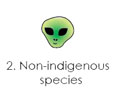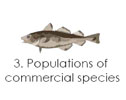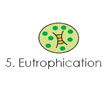Good Environmental Status
The Marine Strategy Framework Directive set out a list of 11 descriptors of environmental status for which good status must be achieved by 2020. These descriptors are further refined in the Commission decision on descriptors (click here) and are described below.
GES Descriptors
Click on the icons below to navigate to the relevant descriptors
 |
 |
 |
 |
 |
 |
||||||
|
|
 |
 |
 |
 |
 |
|
|||||
|
|
|
|
|
|
|
|
|
|
|
|
|
Descriptor 1: Biodiversity
The quality and occurrence of habitats and the distribution and abundance of species are in line with prevailing physiographic, geographic and climatic conditions.
Biodiversity is the variety of life on earth it operates on different scale from genes to ecosystems. Biodiversity refers to all life forms, habitats and the complex relationships between organisms.
A rich ecosystem has many available habitat niches, and many different organisms, which fill those niches. Such a system containing a wide variety of life-forms generally is more resilient to environmental change than one with either a more restricted range of species or where the species present have a narrower range of life-styles. As conditions change, some organisms are less able to survive and reproduce, but others readily take their place. Similarly, species which have a high genetic variability within populations are more resistant to environmental stress than those with a more restricted range of genetic combinations.
For Descriptor 1 the MSFD aims to maintain biodiversity in line with a natural state appropriate to a particular area.
Descriptor 2: Non-indigenous species
Non-indigenous species introduced by human activities are at levels that do not adversely alter the ecosystems.
Non-indigenous species are species whose introduction or spread threaten biodiversity. Non-indigenous species are species introduced to an area which survive and reproduce. Non-indigenous species can have devastating effects on ecosystems and on human activities such as fishing which rely on these ecosystems.
Descriptor 3: Commercial species
Populations of all commercially exploited fish and shellfish are within safe biological limits, exhibiting a population age and size distribution that is indicative of a healthy stock.
Commercially exploited fish and shellfish are all living marine resources targeted for economic profit.
Descriptor 3 has three main implications.
I. Stocks should be exploited sustainably
II. Full reproductive capacity should be maintained
III. The proportion of older and larger fish should be maintained
The level of exploitation under the descriptor 3 should be that of Maximum Sustainable Yield. MSY is the maximum annual catch, which can be taken year after year without reducing the productivity of the fish stock.
Descriptor 4: Marine food webs
All elements of the marine food webs, to the extent that they are known, occur at normal abundance and diversity and levels capable of ensuring the longterm abundance of the species and the retention of their full reproductive capacity.
Food webs are networks of feeding interactions between consumers and their food. This descriptor addresses the rates of energy transfer between the organisms in an ecosystem; the levels of productivity in specific ecosystem components as well as the size and abundance of individuals.
The objective of the descriptor is the same as that of descriptor 3, but also includes species which are not commercially exploited.
Descriptor 5: Human-induced eutrophication
Human-induced eutrophication is minimised, especially adverse effects thereof, such as losses in biodiversity, ecosystem degradation, harmful algae blooms and oxygen deficiency in bottom waters.
Eutrophication is a process driven by the enrichment of water by nutrients, especially compounds of nitrogen and/or phosphorus, leading to: increased growth, primary production and biomass of algae; changes in the balance of organisms; and water quality degradation. The consequences of eutrophication are undesirable if they appreciably degrade ecosystem health and biodiversity and/or the sustainable provision of goods and services.
Nitrogen and phosphorous are the main nutrients responsible for eutrophication, though they occur naturally in the marine environment, excess nutrients coming particularly from agriculture and waste water can cause eco system degradation including blooming of algae and reduced oxygen concentration in bottom waters. There are several other EU pieces of legislation dealing with eutrophication including the Nitrates Directive the Urban Waste-Water Treatment Directive and the Water Framework Directive
Descriptor 6: Sea floor integrity
Sea floor integrity is at a level that ensures that the structure and functions of the ecosystems are safeguarded and benthic ecosystems, in particular, are not adversely affected.
The integrity of the sea floor integrity reflects the physical, chemical and biological characteristics of the sea bottom. These characteristics determine the structure and functioning of marine ecosystems, especially for benthic organisms, those living on the sea floor. The desired qualities of descriptors for a particular location are dependent on the depth, the type of substrate and species composition.
Descriptor 7: Hydrographical conditions
Permanent alteration of hydrographical conditions does not adversely affect marine.
Hydrographical conditions are characterized by the physical characteristics of seawater such as temperature, salinity, depth, currents, waves, turbulence and. These characteristics play a crucial role in the dynamics of marine ecosystems and can be altered by human activities, especially in coastal areas. Alterations to hydrographical conditions can occur due to the construction of physical structures (such as wind trubines) or through excavation of navigational channels.
Descriptor 8: Contaminants
Contaminants are at a level not giving rise to pollution effects.
Contaminants are defined in the European legislation as:
"substances (i.e. chemical elements and compounds) or groups of substances that are toxic, persistent and liable to bio-accumulate and other substances or groups of substances which give rise to an equivalent level of concern" (Water Framework Directive, Article 2(29)).
Examples of such substances found in the marine environment include pesticides, anti-foulants, pharmaceuticals and heavy metals.
Descriptor 9: Contamination of fish and seafoods
Contaminants in fish and other seafood for human consumption do not exceed levels established by Community legislation or other relevant standards.
Marine fish and other seafood such as crustaceans, molluscs or seaweed are an important source of food for humans, the presence of contaminants in the environment can result in high levels of contaminants in marine food stuffs and pose a human health risk.
Descriptor 10: Marine litter
Properties and quantities of marine litter do not cause harm to the coastal and marine environment
Marine litter is a problem not just along coastlines but also in the high seas, as the waste from human activities is often degraded directly which can cause health as well as aesthetic problems.
In particular the breakdown at sea of plastic into tiny particles or microplastics can be detrimental to marine environmental quality.
Descriptor 11: Energy and noise
Introduction of energy, including underwater noise, is at levels that do not adversely affect the marine environment.
Introducing energy such as light, electricity, heat, noise, electromagnetic radiation, radio waves or vibrations can have a negative effect on the marine environment. Underwater noise is of particular concern and heat from cooling water systems can also cause problems. The changes to the environment caused by the introduction of energy depend on the type and duration of the energy introduced. For example, loud, pulsed noise should be distinguished from continuous ambient noise. The location of the energy input relative to organisms of interest is also important.

